11.2: Distance and Midpoint Formulas and Circles
( \newcommand{\kernel}{\mathrm{null}\,}\)
By the end of this section, you will be able to:
- Use the Distance Formula
- Use the Midpoint Formula
- Write the equation of a circle in standard form
- Graph a circle
Before you get started, take this readiness quiz.
- Find the length of the hypotenuse of a right triangle whose legs are 12 and 16 inches.
If you missed this problem, review Example 2.34. - Factor: x2−18x+81.
If you missed this problem, review Example 6.24. - Solve by completing the square: x2−12x−12=0.
If you missed this problem, review Example 9.22.
In this chapter we will be looking at the conic sections, usually called the conics, and their properties. The conics are curves that result from a plane intersecting a double cone—two cones placed point-to-point. Each half of a double cone is called a nappe.
There are four conics—the circle, parabola, ellipse, and hyperbola. The next figure shows how the plane intersecting the double cone results in each curve.
Each of the curves has many applications that affect your daily life, from your cell phone to acoustics and navigation systems. In this section we will look at the properties of a circle.
Use the Distance Formula
We have used the Pythagorean Theorem to find the lengths of the sides of a right triangle. Here we will use this theorem again to find distances on the rectangular coordinate system. By finding distance on the rectangular coordinate system, we can make a connection between the geometry of a conic and algebra—which opens up a world of opportunities for application.
Our first step is to develop a formula to find distances between points on the rectangular coordinate system. We will plot the points and create a right triangle much as we did when we found slope in Graphs and Functions. We then take it one step further and use the Pythagorean Theorem to find the length of the hypotenuse of the triangle—which is the distance between the points.
Use the rectangular coordinate system to find the distance between the points (6,4) and (2,1).
Solution
| Plot the two points. Connect the two points with a line. Draw a right triangle as if you were going to find slope. |
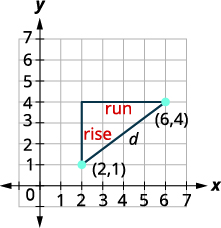
|
| Find the length of each leg. |
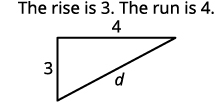
|
| Use the Pythagorean Theorem to find d, the distance between the two points. | a2+b2=c2 |
| Substitute in the values. | 32+42=d2 |
| Simplify. | 9+16=d2 |
| 25=d2 | |
| Use the Square Root Property. | d=5d=−5 |
| Since distance, d is positive, we can eliminate d=−5. | The distance between the points (6,4) and (2,1) is 5. |
Use the rectangular coordinate system to find the distance between the points (6,1) and (2,−2).
- Answer
-
d=5
Use the rectangular coordinate system to find the distance between the points (5,3) and (−3,−3).
- Answer
-
d=10
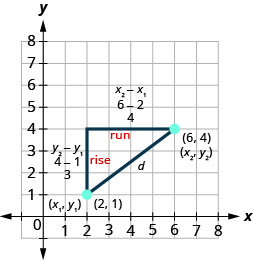
The method we used in the last example leads us to the formula to find the distance between the two points (x1,y1) and (x2,y2).
When we found the length of the horizontal leg we subtracted 6−2 which is x2−x1.
When we found the length of the vertical leg we subtracted 4−1 which is y2−y1.
If the triangle had been in a different position, we may have subtracted x1−x2 or y1−y2. The expressions x2−x1 and x1−x2 vary only in the sign of the resulting number. To get the positive value-since distance is positive- we can use absolute value. So to generalize we will say |x2−x1| and |y2−y1|.
In the Pythagorean Theorem, we substitute the general expressions |x2−x1| and |y2−y1| rather than the numbers.
a2+b2=c2Substitute in the values. (|x2−x1|)2+(|y2−y1|)2=d2Squaring the expressions makes(x2−x1)2+(y2−y1)2=d2them positive, so we eliminatethe absolute value bars.Use the Square Root Property.d=±√(x2−x1)2+(y2−y1)2Distance is positive, so eliminated=√(x2−x1)2+(y2−y1)2the negative value.
This is the Distance Formula we use to find the distance d between the two points (x1,y1) and (x2,y2).
Distance Formula
The distance d between the two points (x1,y1) and (x2,y2) is
d=√(x2−x1)2+(y2−y1)2
Use the Distance Formula to find the distance between the points (−5,−3) and (7,2).
Solution:
Write the Distance Formula.
d=√(x2−x1)2+(y2−y1)2
Label the points, (x1,y1−5,−3), (x2,y27,2) and substitute.
d=√(7−(−5))2+(2−(−3))2
Simplify.
d=√122+52
d=√144+25
d=√169
d=13
Answer:
d=13
Use the Distance Formula to find the distance between the points (−4,−5) and (5,7).
- Answer
-
d=15
Use the Distance Formula to find the distance between the points (−2,−5) and (−14,−10).
- Answer
-
d=13
Use the Distance Formula to find the distance between the points (10,−4) and (−1,5). Write the answer in exact form and then find the decimal approximation, rounded to the nearest tenth if needed.
Solution:
Write the Distance Formula.
d=√(x2−x1)2+(y2−y1)2
Label the points, (x1,y110,−4), (x2,y2−1,5) and substitute.
d=√(−1−10)2+(5−(−4))2
Simplify.
d=√(−11)2+92
d=√121+81
d=√202
Since 202 is not a perfect square, we can leave the answer in exact form or find a decimal approximation.
d=√202
or
d≈14.2
Use the Distance Formula to find the distance between the points (−4,−5) and (3,4). Write the answer in exact form and then find the decimal approximation, rounded to the nearest tenth if needed.
- Answer
-
d=√130,d≈11.4
Use the Distance Formula to find the distance between the points (−2,−5) and (−3,−4). Write the answer in exact form and then find the decimal approximation, rounded to the nearest tenth if needed.
- Answer
-
d=√2,d≈1.4
Use the Midpoint Formula
It is often useful to be able to find the midpoint of a segment. For example, if you have the endpoints of the diameter of a circle, you may want to find the center of the circle which is the midpoint of the diameter. To find the midpoint of a line segment, we find the average of the x-coordinates and the average of the y-coordinates of the endpoints.
Midpoint Formula
The midpoint of the line segment whose endpoints are the two points (x1,y1) and (x2,y2) is
(x1+x22,y1+y22)
To find the midpoint of a line segment, we find the average of the x-coordinates and the average of the y-coordinates of the endpoints.
Use the Midpoint Formula to find the midpoint of the line segments whose endpoints are (−5,−4) and (7,2). Plot the endpoints and the midpoint on a rectangular coordinate system.
Solution:
| Write the Midpoint Formula. | (x1+x22,y1+y22) |
| Label the points, (x1,y1−5,−4),(x2,y27,2) and substitute. | (−5+72,−4+22) |
| Simplify. | (22,−22) |
|
(1,−1) The midpoint of the segment is the point (1,−1). |
|
| Plot the endpoints and midpoint. |
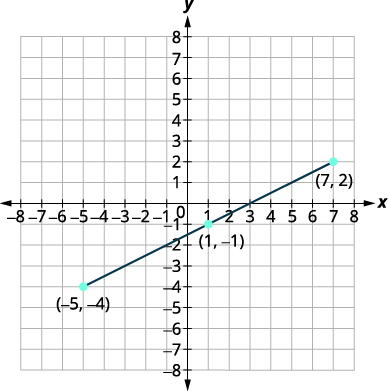
|
Use the Midpoint Formula to find the midpoint of the line segments whose endpoints are (−3,−5) and (5,7). Plot the endpoints and the midpoint on a rectangular coordinate system.
- Answer
-
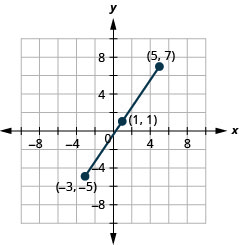
Figure 11.1.7
Use the Midpoint Formula to find the midpoint of the line segments whose endpoints are (−2,−5) and (6,−1). Plot the endpoints and the midpoint on a rectangular coordinate system.
- Answer
-
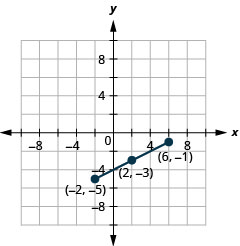
Figure 11.1.8
Both the Distance Formula and the Midpoint Formula depend on two points, (x1,y1) and (x2,y2). It is easy to confuse which formula requires addition and which subtraction of the coordinates. If we remember where the formulas come from, is may be easier to remember the formulas.

Write the Equation of a Circle in Standard Form
As we mentioned, our goal is to connect the geometry of a conic with algebra. By using the coordinate plane, we are able to do this easily.

We define a circle as all points in a plane that are a fixed distance from a given point in the plane. The given point is called the center, (h,k), and the fixed distance is called the radius, r, of the circle.
A circle is all points in a plane that are a fixed distance from a given point in the plane. The given point is called the center, (h,k), and the fixed distance is called the radius, r, of the circle.
We look at a circle in the rectangular coordinate system. The radius is the distance from the center, (h,k),to a point on the circle, (x,y). |
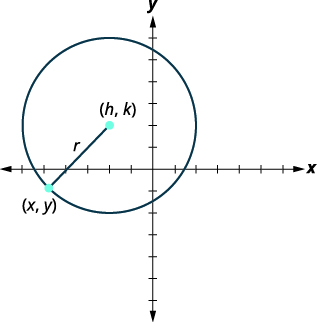
|
| To derive the equation of a circle, we can use the distance formula with the points (h,k), (x,y) and the distance, r. |
d=√(x2−x1)2+(y2−y1)2 |
| Substitute the values. | r=√(x−h)2+(y−k)2 |
| Square both sides. | r2=(x−h)2+(y−k)2 |
This is the standard form of the equation of a circle with center, (h,k), and radius, r.
The standard form of the equation of a circle with center, (h,k), and radius, r, is
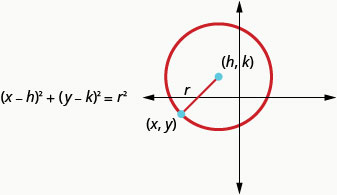
Write the standard form of the equation of the circle with radius 3 and center (0,0).
Solution:
| Use the standard form of the equation of a circle | (x−h)2+(y−k)2=r2 |
| Substitute in the values r=3,h=0, and k=0. | (x−0)2+(y−0)2=32 |
 |
|
| Simplify. | x2+y2=9 |
Write the standard form of the equation of the circle with a radius of 6 and center (0,0).
- Answer
-
x2+y2=36
Write the standard form of the equation of the circle with a radius of 8 and center (0,0).
- Answer
-
x2+y2=64
In the last example, the center was (0,0). Notice what happened to the equation. Whenever the center is (0,0), the standard form becomes x2+y2=r2.
Write the standard form of the equation of the circle with radius 2 and center (−1,3).
Solution:
| Use the standard form of the equation of a circle. | (x−h)2+(y−k)2=r2 |
| Substitute in the values. | (x−(−1))2+(y−3)2=22 |
 |
|
| Simplify. | (x+1)2+(y−3)2=4 |
Write the standard form of the equation of the circle with a radius of 7 and center (2,−4).
- Answer
-
(x−2)2+(y+4)2=49
Write the standard form of the equation of the circle with a radius of 9 and center (−3,−5).
- Answer
-
(x+3)2+(y+5)2=81
In the next example, the radius is not given. To calculate the radius, we use the Distance Formula with the two given points.
Write the standard form of the equation of the circle with center (2,4) that also contains the point (−2,1).
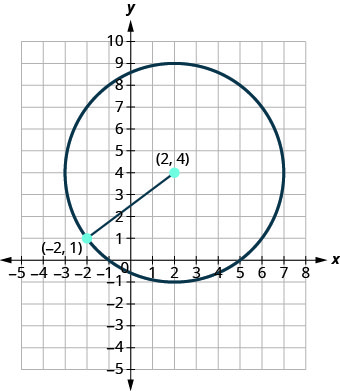
Solution:
The radius is the distance from the center to any point on the circle so we can use the distance formula to calculate it. We will use the center (2,4) and point (−2,1)
Use the Distance Formula to find the radius.
r=√(x2−x1)2+(y2−y1)2
Substitute the values. (x1,y12,4),(x2,y2−2,1)
r=√(−2−2)2+(1−4)2
Simplify.
r=√(−4)2+(−3)2
r=√16+9
r=√25
r=5
Now that we know the radius, r=5, and the center, (2,4), we can use the standard form of the equation of a circle to find the equation.
Use the standard form of the equation of a circle.
(x−h)2+(y−k)2=r2
Substitute in the values.
(x−2)2+(y−4)2=52
Simplify.
(x−2)2+(y−4)2=25
Write the standard form of the equation of the circle with center (2,1) that also contains the point (−2,−2).
- Answer
-
(x−2)2+(y−1)2=25
Write the standard form of the equation of the circle with center (7,1) that also contains the point (−1,−5).
- Answer
-
(x−7)2+(y−1)2=100
Graph a Circle
Any equation of the form (x−h)2+(y−k)2=r2 is the standard form of the equation of a circle with center, (h,k), and radius, r. We can then graph the circle on a rectangular coordinate system.
Note that the standard form calls for subtraction from x and y. In the next example, the equation has x+2, so we need to rewrite the addition as subtraction of a negative.
Find the center and radius, then graph the circle: (x+2)2+(y−1)2=9.
Solution:
 |
|
|
Use the standard form of the equation of a circle. Identify the center, (h,k) and radius, r. |
 |
| Center: (−2,1) radius: 3 | |
| Graph the circle. |  |
- Find the center and radius, then
- Graph the circle: (x−3)2+(y+4)2=4.
- Answer
-
- The circle is centered at (3,−4) with a radius of 2.
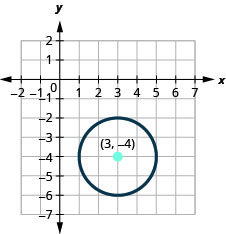
Figure 11.1.19
- Find the center and radius, then
- Graph the circle: (x−3)2+(y−1)2=16.
- Answer
-
- The circle is centered at (3,1) with a radius of 4.
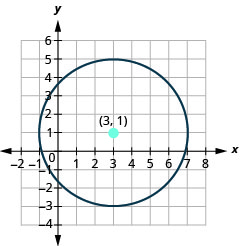
Figure 11.1.20
To find the center and radius, we must write the equation in standard form. In the next example, we must first get the coefficient of x2,y2 to be one.
Find the center and radius and then graph the circle, 4x2+4y2=64.
Solution:
 |
|
| Divide each side by 4. |  |
| Use the standard form of the equation of a circle. Identify the center, (h,k) and radius, r. |
 |
| Center: (0,0) radius: 4 | |
| Graph the circle. | 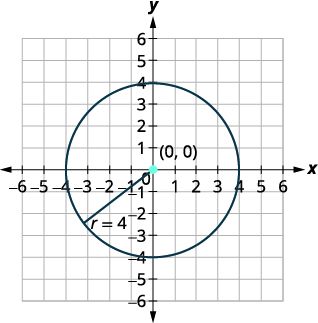 |
- Find the center and radius, then
- Graph the circle: 3x2+3y2=27
- Answer
-
- The circle is centered at (0,0) with a radius of 3.
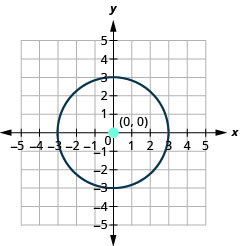
Figure 11.1.25
- Find the center and radius, then
- Graph the circle: 5x2+5y2=125
- Answer
-
- The circle is centered at (0,0) with a radius of 5.
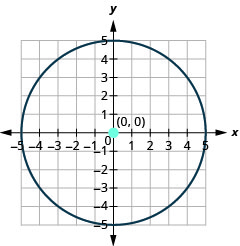
Figure 11.1.26
If we expand the equation from Example 11.1.8, (x+2)2+(y−1)2=9, the equation of the circle looks very different.
(x+2)2+(y−1)2=9
Square the binomials.
x2+4x+4+y2−2y+1=9
Arrange the terms in descending degree order, and get zero on the right
x2+y2+4x−2y−4=0
This form of the equation is called the general form of the equation of the circle.
The general form of the equation of a circle is
x2+y2+ax+by+c=0
If we are given an equation in general form, we can change it to standard form by completing the squares in both x and y. Then we can graph the circle using its center and radius.
- Find the center and radius, then
- Graph the circle: x2+y2−4x−6y+4=0
Solution:
We need to rewrite this general form into standard form in order to find the center and radius.

|
|
| Group the x-terms and y-terms. Collect the constants on the right side. |

|
| Complete the squares. |

|
| Rewrite as binomial squares. |

|
| Identify the center and radius. | Center: (2,3) radius: 3 |
| Graph the circle. |
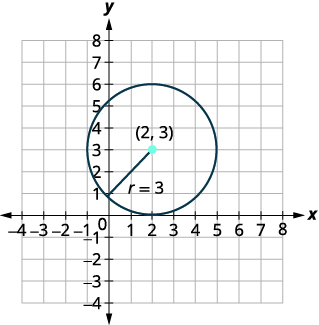
|
- Find the center and radius, then
- Graph the circle: x2+y2−6x−8y+9=0.
- Answer
-
- The circle is centered at (3,4) with a radius of 4.
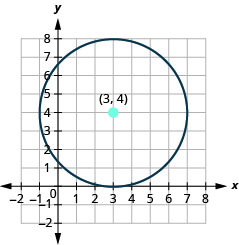
Figure 11.1.32
- Find the center and radius, then
- Graph the circle: x2+y2+6x−2y+1=0
- Answer
-
- The circle is centered at (−3,1) with a radius of 3.
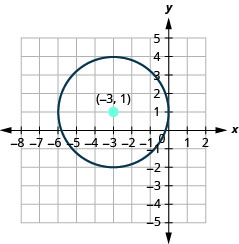
Figure 11.1.33
In the next example, there is a y-term and a y2-term. But notice that there is no x-term, only an x2-term. We have seen this before and know that it means h is 0. We will need to complete the square for the y terms, but not for the x terms.
- Find the center and radius, then
- Graph the circle: x2+y2+8y=0
Solution:
We need to rewrite this general form into standard form in order to find the center and radius.
 |
|
| Group the x-terms and y-terms. |  |
| There are no constants to collect on the right side. | |
| Complete the square for y2+8y. |  |
| Rewrite as binomial squares. |  |
| Identify the center and radius. | Center: (0,−4) radius: 4 |
| Graph the circle. | 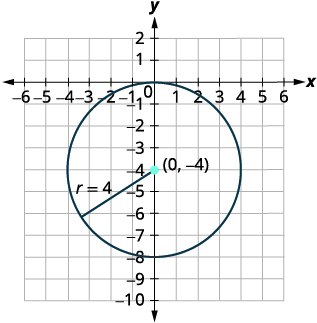 |
- Find the center and radius, then
- Graph the circle: x2+y2−2x−3=0.
- Answer
-
- The circle is centered at (−1,0) with a radius of 2.
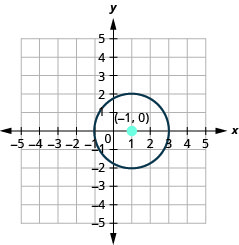
Figure 11.1.39
- Find the center and radius, then
- Graph the circle: x2+y2−12y+11=0.
- Answer
-
- The circle is centered at (0,6) with a radius of 5.
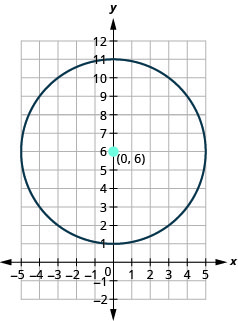
Figure 11.1.40
Access these online resources for additional instructions and practice with using the distance and midpoint formulas, and graphing circles.
- Distance-Midpoint Formulas and Circles
- Finding the Distance and Midpoint Between Two Points
- Completing the Square to Write Equation in Standard Form of a Circle
Key Concepts
- Distance Formula: The distance d between the two points (x1,y1) and (x2,y2) is
d=√(x2−x1)2+(y2−y1)2
- Midpoint Formula: The midpoint of the line segment whose endpoints are the two points (x1,y1) and (x2,y2) is
(x1+x22,y1+y22)
To find the midpoint of a line segment, we find the average of the x-coordinates and the average of the y-coordinates of the endpoints. - Circle: A circle is all points in a plane that are a fixed distance from a fixed point in the plane. The given point is called the center, (h,k), and the fixed distance is called the radius, r, of the circle.
- Standard Form of the Equation a Circle: The standard form of the equation of a circle with center, (h,k), and radius, r, is
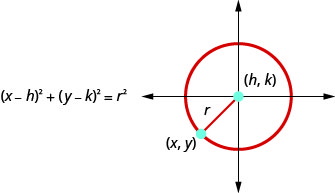
- General Form of the Equation of a Circle: The general form of the equation of a circle is
x2+y2+ax+by+c=0
Glossary
- circle
- A circle is all points in a plane that are a fixed distance from a fixed point in the plane.


